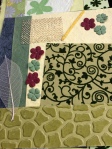If you’re interested in creativity, it is relatively safe to assume that Julia Cameron’s The Artist’s Way has been recommended to you at some stage. Let me now also recommend Elizabeth Gilbert’s Big Magic. She believes that the essential ingredients for creativity are courage, enchantment, permission, persistence and trust:
To live a creative life means having courage. It means living a life that is driven more by curiosity than by fear. But keep in mind that creativity always triggers fear because creativity implies uncertain outcome, which is exactly what fear hates.
The creative process is both magical and magic. Ideas “walk” among us and are available to everybody that are willing and able to help those ideas come to “life”, as it were.
“You do not need anybody’s permission to live a creative life.”
Persistence: Learning how to endure disappointments and frustration is part of the creative person’s process. Holding yourself together when things aren’t going as well as you would have liked, that is where the real work lies.
Trust that the work wants to be made, and it wants to be made through you.
Something else that resonated with me was the admonition that “eventually you will have to do the work by yourself” and that “it is ultimately entirely up to you.” You could have the best training, the best supplies or not. Still, you have to do the work.
And for those battling with nasty negative self-talk, Gilbert believes that creative entitlement is the cure. Creative entitlement, or what the poet David Whyte calls “the arrogance of belonging”, is the simple belief that you are allowed to be here (because you were born, after all). And because you’re allowed to be here, you’re therefore allowed to have a voice and a vision of your own.
I found Big Magic to be inspirational in a straight-forward practical way without sugar-coating.





